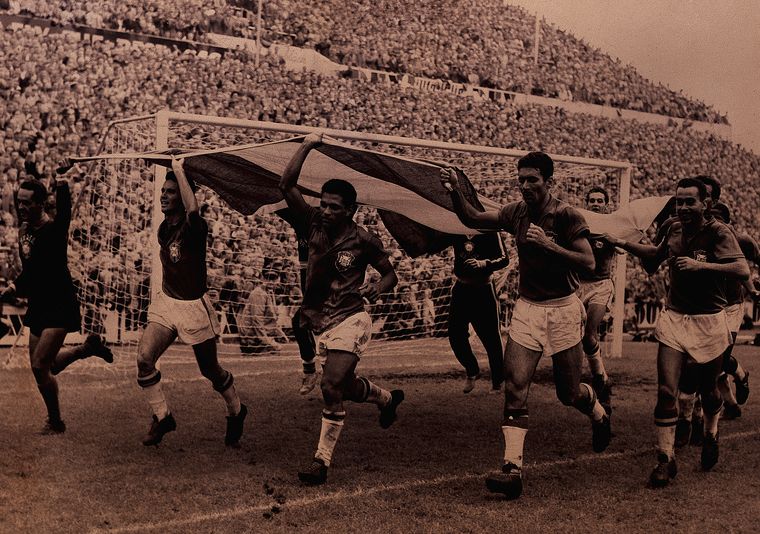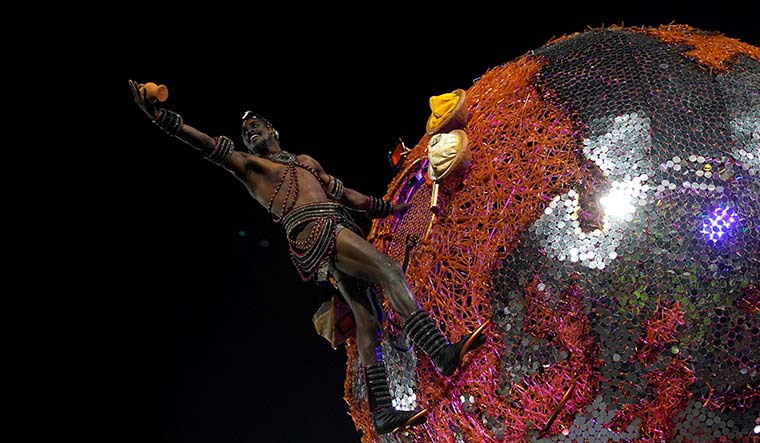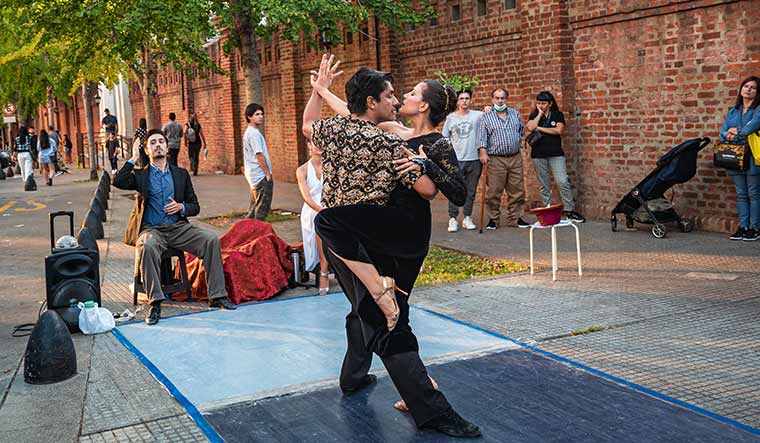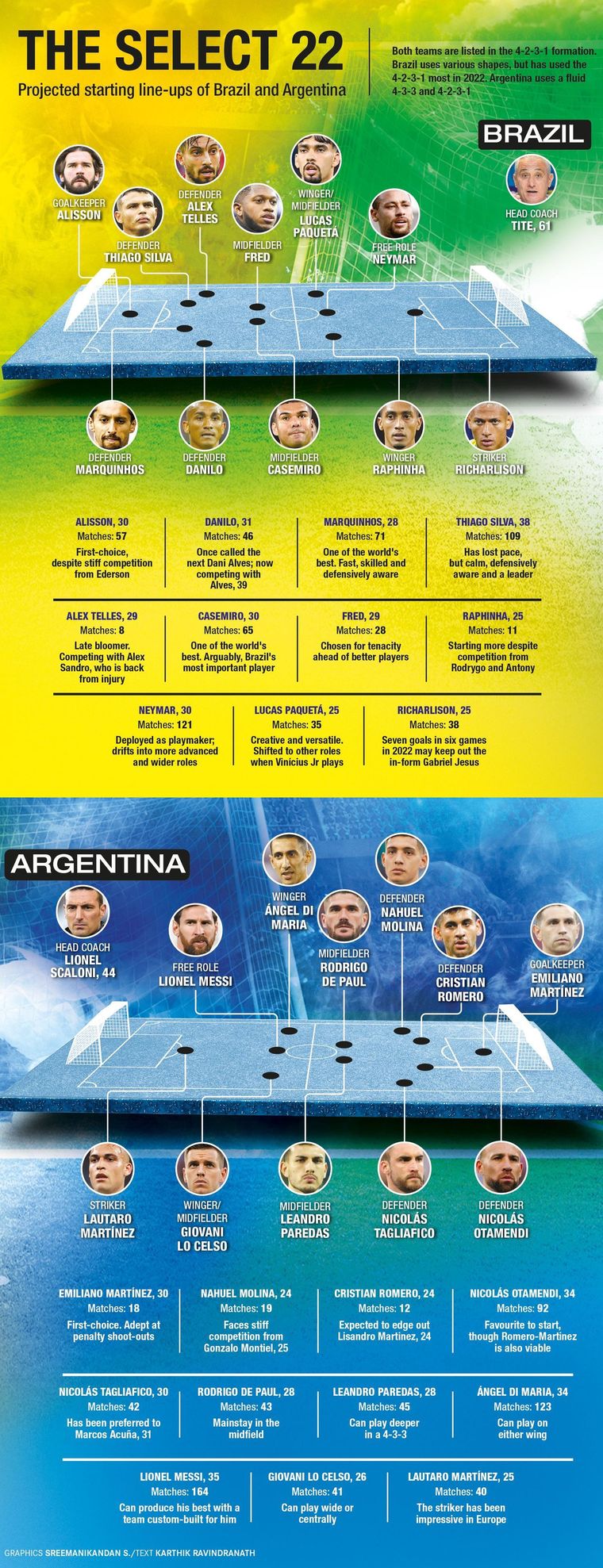Rising less than a metre from the edge of the sidewalk in Buenos Aires’s Boca neighbourhood, tall, blue-topped gold columns mark the massive perimeter of the chocolate-box-like La Bombonera, one of the world’s grand temples of football. The Alberto José Armando Stadium is set in a working-class, Italian-immigrant neighbourhood at the mouth of the Riachuelo waterway where its waters flow into the Río de la Plata.
Looking and feeling a lot like the South Side of Chicago, the area takes a sudden and decidedly Argentinian air as one notices the different colours of wooden and corrugated-tin walls that clad the houses, and then there are the milonga dancers, street tables, and bars that brighten the storied El Caminito, the little road of tango fame that inspired its name.
Under the imposing shade of the stadium, home of the popular Boca Juniors club, one feels that there is more in the moment than concrete and colours. Standing there, tempted by the smells of chimichurri-topped choripán sandwiches from the street grills and serenaded by the romantic strands of tango from the traditional bandoneon, one can almost hear the drums and the fans inside, ghosts of games that go back a half-a-century and more.
Two-thousand kilometres north of La Bombonera, at the majestic Maracanã stadium in Rio de Janeiro, too, the ghosts of games past live. Sitting in the empty stands, you can feel Brazil’s disappointment at its loss to Uruguay in the final of the World Cup in 1950, the year Argentina withdrew its participation due to “a disagreement with the Brazilian Football Confederation”.
It was a golden age in Argentine football, wrote journalist Rex Gowar, reporting for Reuters. He said the disagreement was “a mass exodus of their most talented players”.
According to Gowar, the decision led Argentina to “years of national grief”. On the other side, “Brazil were miffed by the perceived Argentine snub and did not support their neighbours' bid to bring the World Cup back to the region,” wrote Gowar.
It would mark just one turning point in the long-running Brazil-Argentina football relationship and rivalry, which will continue in Qatar 2022, where the top-ranked Brazil and third-placed Argentina will be the favourites to lift the Cup. They say cricket is “a game of glorious uncertainties”, but the same holds true for “the beautiful game”, too. In Brazil 2014, the hosts were vanquished 1-7 by Germany in the semifinal at Mineirão. Argentine fans, who came in droves to the Maracanã to watch their team play the final against Germany, did not forget to remind the Brazilians about the humiliating defeat. Brazilians got their revenge of sorts when 22-year-old German substitute striker Mario Goetze slammed the ball into the Argentine goal in the 23rd minute of extra time in the final and left the Albiceleste devastated. As the Germans celebrated, the Brazilians lit up the iconic Christ the Redeemer statue in the winner's red, yellow and black colours.
The setting of Maracanã stadium is as different from the setting of La Bombonera as are the two countries, their cultures, and football styles. It is not tucked into a neighbourhood like its Buenos Aires counterpart, but it is as much a cathedral of football as the other. It dominates the entire cityscape around it and once held two lakh fans; Boca’s capacity is shy of 50,000. Brazil’s population is 21.5 crore to Argentina’s 4.59 crore.
Far from the traditional areas of the city, one can see the Tijuca urban forest in the distance; there are city parks, tennis courts, and pedestrian skyways that cross and curve their way to the stadium’s grand entrance. A short distance from there lies the São Cristóvão neighbourhood, once the grounds of Brazil’s imperial family and secondary residence of Emperor Dom Pedro II. The expansive grounds are now home to the vast Quinta da Boa Vista municipal park where football is played, and people picnic in the afternoons.
The neighbourhoods around these iconic stadiums are as distinct as the histories of their two former colonial powers. Spain and Portugal, European rivals in conquest, harboured sentiments of distrust in their colonies in the New World.
The Portuguese landed in Brazil, north of Rio de Janeiro, around Easter in 1500. They were on their way to India when they “discovered” the land. Lisbon, intent on not losing its claim to the land, leased it to merchants who would exploit the native redwood tree that could be used instead of the more expensive red dye from India.
Thirty-five years later, attracted by stories of Inca gold in Peru, 2000 Spaniards landed in Argentina and followed myths of rivers of silver (Río de la Plata). The very name Argentina is derived from Argentum, the Latin name for silver, an illusion that would disappoint as explorers lost their hopes in the hostile and vast Pampas. The silver, it turned out, came from a rich silver-bearing hill in Potosi (in present-day Bolivia); the rains washed dust from the ore into the rivers, reflecting a silver lining at dusk. Argentina’s character is built out of disappointment and broken dreams.
Great silver riches were never found in Argentina, but gold was found in Brazil. That brought forth fortune hunters, artisans, craftsmen and new settlers from all over the world. Today, over 43 per cent of its population is of mixed black and white ancestry. With a 7.6 per cent black population, the two groups compose the majority in the country.
In today’s Argentina, 85 per cent of the population is white, with only 11 per cent mestizos of mixed white and native blood. That lack of a black population in Argentina, however, may be a Potemkin village of sorts. A 2008 University of Brasilia study on “The impact of migrations on the genetic constitution of Latin American populations" shows that as much as 9 per cent of Argentina’s population is of African ancestry, a fact not found in its history books. Heavy European immigration to Argentina was continuous, and its heavy composition of Italian and Spanish immigrants during WWII worked well for the country's policy of “whitening” the population.
Argentines have been described in the early last century as “the Yankees of the south”. The Yankees of the south these days are the Brazilians―in their continental reach, size of population, and cultural similarities.
Race is an element in Brazilian culture and football; its rulers, too, had an immigration-based “whitening” policy. But racism was not the big factor it was in the United States. Discrimination existed, and exists, to be sure, and there is a history of racial friction, but it lacked the ardent racial hatred that followed the American Civil War.
The histories of the two countries differ in the way they became independent nations. While Argentina followed the traditional South American mould of a liberator battling to free the country from its colonial oppressors, Brazil was a colony that became a kingdom, and then an independent empire before becoming a republic.
Football came to Argentina much earlier than to Brazil. It was the British railway workers who began games between themselves in 1867, the first-ever game played in Argentina taking place on June 20 of that year, according to football writer Jonathan Wilson in his book Angels With Dirty Faces: The Footballing History of Argentina.
The beginning of football in Brazil is a bit cloudier; it was in the 1890s that the first game was played―either in Rio de Janeiro or São Paulo. What is not contested is that it was British expats who brought the game. Like in Argentina, however, it soon became a national passion. In both countries, football has unified countrymen behind a national identity, used by politicians, and driven cultural change.
The first clubs in both countries were formed by the elites―white members of the upper class. As was common in the early part of the last century, outsiders were seldom welcome.
In Brazil, as elsewhere in the Americas, society was struggling with the acceptance of the former slaves, though as football moved to the streets, blacks did find themselves immersed in a game that was becoming ubiquitous.
Author Alex Bellos, in his book Futebol: The Brazilian Way of Life, tells the story of Carlos Alberto, the first black to play at Fluminense, who applied rice flour to whiten his skin. He was not the only one. Arthur Friedenreich, perhaps Brazil’s first black football superstar, who is said to have scored over 1,200 goals and helped Brazil win two South American championships, also used rice flour to change complexion.
When dictator Getulio Vargas set out to mix and remake Brazilian society to ease racial relations, he was engineering a new Brazilian culture that included popular Afro and poor class elements. Samba and football became the vehicles to deliver the new acceptance. Football bettered Brazilian society, and black and mixed-race players bettered Brazilian football.
In Argentina, the pibe―the irreverent kid with the dirty face, unruly mane, and rebellious attitude―played a similar role in mixing the classes with his trickster quick wit with the ball and fast feet on the pitch. It sounds like a description of Maradona, who was the quintessential pibe.
Pibes like Maradona are the difference between Argentine and Brazilian football, says football coach Silas Eduardo Severino, the founder of the Brazuquinhas Academy, the largest network of football schools in Brazil.
Brazil is hot, he says. Poor kids cannot stay indoors, they come out and play in the streets, they stay outside all day and the culture is happy, playful. Argentina has poor kids, too, but it is colder there, less sun. Kids have to seek refuge from the cold. “There is no comparison,” says Severino. “They grow up with tango. Tango is drama, samba is joyful.”
That swing, that charm, that smile, those clownish things, that is the essence of Brazilian football, he explains. “Argentine kids, they have a European climate, they have to hide and protect themselves,” he says. “They are more rascals than clowns. More secretive, less trusting. The Argentines fight. They do not give up; even if the result is not in their favour, they do not give up easily.”
Brazilians, he says, are more sentimental because they believe in art. “In all generations of Brazilian players, art has always been there: Didi, Pelé, Garrincha, Gaúcho (Ronaldinho), Neymar... they have an enchantment... like a circus, with the clowns,” he says.
Whoever goes to the circus likes the palhaço (clown or jester), says Severino. “Brazilian players have many characteristics of a clown. Brazilian football is sentimental, it makes people cry. Brazilian players make people laugh, make them happy. That is a central point of Brazilian football, it is most enjoyable.”
What made Maradona great, says Severino, is that he was a bit of a palhaço, but like fellow Argentines, he was objective and was a fighter. “But the palhaçadas of Brazil score more goals and set up others to score,” he says. “The Argentine is a warrior, a fighter. Messi is objective.”
According to him, objectivity is the key to winning. “Romario played objectively in 1994 and helped Brazil win the Cup,” said Severino. “There he was, a small guy, playing against taller defenders. He charged, he dribbled once, dribbled twice, turned to one side, then the other, stopped, shot, and scored a goal. That is magic! The goal that he scored against Holland. The ball hits the face of the player, he turns around.... It is a spectacle, so people like it.”
Messi, says Severino, is not a palhaço. As a Brazilian, it is but natural that he rates Pelé as a better palhaço than Maradona. "You look at all the plays of Maradona, it's beautiful, very good.... But Pelé did things that Maradona never did, and Pelé did everything Maradona did,” he says, quickly adding, “outside the hand goal”.
The Argentinian game is modelled after Spanish football, which is characterised by a dependence on the ground game. Messi is a product of that system. “Messi is good at driving the ball,” says Severino. “The Italians play a more aerial game. Argentine football has a Spanish style and Italian behaviour.”
The things the Brazilian team did at the 1970 Cup define Brazilian football in general, says Severino. “The beautiful moves, the tip of the foot kicks, they were entertaining, they were effective. They won hearts and they won games.”
“The one big misconception is that the 1970 Brazil team won merely or primarily because of their style and creativity,” says journalist and author Andrew Downie, who wrote The Greatest Show on Earth: The Inside Story of the Legendary 1970 World Cup. “They, of course, had some of the greatest players in the world―Pelé, Jairzinho, Tostão, Rivelino, Carlos Alberto. The greatness of those players may be masked by a lot of preparedness for the tournament. (Mexico’s Aztec stadium is at an altitude of 2,200m above sea level.) Brazil trained more than anyone for that tournament. The proof is that 10 of their 19 goals came in the second half.”
But it was much more than that. Downie explains how Brazil’s goal in the final against Italy was a product of tactical preparation more than the creativity of that Clodoaldo dribbling everybody talks about.
Before the game, says Downie, the Brazilian players were shown stills from the other semifinal game. It helped Carlos Alberto's men to tackle the opposition better. “So that goal against Italy in the final was born in the slides and preparation days before the game,” says Downie.
Downie's conclusion is that Brazilians always believed that, all other things being equal, they were more skilful than players from other countries. That if they could match them physically, once they had the ball they would win.
Nowadays, when Argentina and Brazil play, the parameters that would make a difference with other teams are smaller, says Downie. “They are teammates, they play each other every week, they see each other every week. The difference in style is not as big as it was 20 to 30 years ago.”
The days when you would sign a Brazilian player at the age of 25 when he was a complete footballer are gone, explains Downie. These days kids are going to Europe in their teens and are taught to play the same game as the Europeans.
The 1959 football match that resulted in a fierce physical fight on the pitch as the two teams played in the South American championship was the game-changer, says Downie. It changed both the teams. Argentina had always been more physical, Brazil fought back, and Argentina knew they would not be able to be that physical with the Brazilians again.
In the streets and central markets of São Paulo and Buenos Aires today, the food smells wrap in their smoky, fatty scents the cultural and culinary essence of the two superpowers of South American football. It is in these streets as much as in the football stadiums that something magical happens.
From Amazonia to Patagonia across the wildly varying geography, football is the mirror of the soul of the two nations that cover the bulk of the subcontinent. In the last century, the rivalry between the two countries has been more than a sport. There is serious competitiveness. Brazil is the largest economy in South America. Argentina is second. But it was not always that way. In the late 1960s, Argentina accounted for 39 per cent of South America’s GDP, and Brazil, 26 per cent. Today, those numbers are: Argentina, 14 per cent, and Brazil, 50.6 per cent. This has created grand shifts in how the two countries feel about each other.
Argentines and Brazilians have seen each other as enemies, not just on the football field, but for most past of the last century. They even created their own nuclear agencies to defend against and attack each other. It was a war mentality between the two until 1985, when Brazil came out of a 21-year military dictatorship.
Argentina’s first democratically elected president after more than seven years of their own military dictatorship, Raul Alfonsin, approached Brazil with the idea of a peaceful economic cooperation and integration around the European Union model. The two countries eventually abandoned their enmity and, in 1991, established a Binational Nuclear Control Commission based in Rio de Janeiro. In the same year, along with Paraguay and Uruguay, they created the Mercosur trading bloc, calling for “free movement of goods, services, and factors of production” between countries.
There have been political differences, mostly along the right-wing, left-wing seesaw of Latin American politics. Most recently, Brazil’s ultra-rightist Jair Bolsonaro clashed with the leftist government of Alberto Fernández elected to replace the rightist Mauricio Macri, friend to Bolsonaro and Trump.
Still, during the presidency of the warring presidents, Brazil supported the creation of a common currency with Argentina. Today, Argentina has a rapidly deflating currency and an inflation rate of 83 per cent (in September). Brazil’s currency is relatively stable and its inflation is at an annual rate of 10.07 per cent. When former president Lula, a leftist, defeated Bolsonaro this October 30, the first international visitor he received was the Argentine president who flew to São Paulo for the October 31 meeting.
The difference between the countries extend to the women, too. Brazilian women are conscious of their own femininity and sensuality. They wear it in every curve and the way they balance the swing of their steps even in the kitchen, very keenly aware of their effect on the world around them. Make-up is often not enough, and many have resorted to surgical and non-surgical cosmetic procedures from facelifts to butt-lifts and breast enhancements. It is natural to be unnatural.
Beauty means something else in Argentina. Not that Argentines cannot appreciate the same beauty as Brazilians, it is just that they embrace as beautiful a woman’s natural figure, a mostly unadulterated look and her given complexion. Make-up is largely limited to the lips and eyebrows.
If she is shopping for a family meal, she is likely looking at a hunk of golden tenderloin or succulent chorizos ready to burst over the fire. Besides football, that is the national obsession, a good steak (often cooked by the men), and all kinds of meats cut into thick, bite-size pieces so one can get a few and come back for more. Argentines call that the vaivén, the go-and-come-back for more.
On the grill the meat hisses and puffs steam like a tiny pressure cooker, fat accumulates and drips on to the coals, only to sizzle and rise in explosions of a salty smoke that is as much the aroma of Argentina.
In the South American sibling rivalry, Brazil too gets lost and identified in the smoky aromas and sounds of meat on the grill, though its people prefer it skewered on sticks in chunks of five or six. Brazilians are meat lovers, but a cacophony of scents fills the air in homes and street restaurants. The smells of boiled rice, boiling black bean feijoada and the hissing of deep-frying pastels tell the history of its people.
Also read
- Future's bright for World Cup winners Argentina. Here's why
- Story of FIFA World Cup 2022 in 10 photos
- These two clubs had players in every World Cup final since 1982
- Qatar 2022: Antonio Lahoz, the referee who Messi confronted, sent home
- Qatar 2022: Adidas reveals 'Al Hilm', official match ball for FIFA World Cup finals
- Qatar World Cup: Four unsung heroes and why they are vital to their teams
While the history of all of the Americas is the story of three peoples―the natives, the Europeans, and the Africans brought by them as slaves―more than any other country Brazil is made of the integration and influence of these three peoples into one distinct modern nationality. Argentina, on the other hand, is of mostly European influence with a Latin flavour.
The two countries represent eastern South America versus southern South America, each saddled with large, resource-rich, and largely economically isolated regions―Amazonia and Patagonia, both the largest in area of their respective countries.
Those regions define the people of the countries. One, a hot, humid, tropical rainforest where rain comes in as much as 400 inches per year, and the other open bushland, salt flats and mountains where rain can vary from 3.5 to 17 inches per year.
The music, too, varies. The regions influence very different musics that are the soundtrack of national life. African sounds, tropical heat, the flow and mix mark the beat of the pulse of Brazil. Samba draws on the preto velho―the patient, forgiving, and generous spirits that are said to descend upon the images of old slaves who died of old age, the ones who learned to squeeze happiness out of bitter days.
Tango slices the air in Buenos Aires milongas with a sad force that is as much nostalgia as it emotes desperation. Here, too, one can feel how Argentines and Brazilians do sensuality differently; the Patagonians do it with passion and strength, the Amazonians do it with flow, playfulness, and beauty.
Of course, these are all stereotypes, but they carry a larger truth. Brazil’s play has been described as “beautiful” whereas Argentina’s, “guts and agony”.
Perhaps that is the whole difference.
Their 105 matches against each other have yielded 41 victories for Brazil against 38 for Argentina; 163 goals for Brazil vs 160 for Argentina. The teams have met in the Olympics twice, each winning once. Brazil has won 5 World Cups, the last in 2002; Argentina 2, with the last in 1986.
The wisdom, truth, and sincerity of football between these two great rivals live in the fans as much as in the players.
“The symbolic construction of football is very similar in both countries,” writes sociologist and professor at the University of the State of Rio de Janeiro Ronaldo Helal in his work Jogo Bonito y Futbol Criollo: The Football Relationship Between Brazil and Argentina in the Media. “Brazil and Argentina ‘built’ for themselves an image of a style of play based on dribbling, ‘waist play’, improvisation and spontaneity as opposed to the rigidity of tactical schemes that would be typical of European football in a generalised way in the Brazilian case, and English, in the Argentine case.”
Driven mainly by Argentina’s precarious economy and the economic disparity between the two countries, 2022 has seen 13 Argentine players move to the Brazilian league, something previously unheard of. Multi-million-dollar purchases by Palmeiras of José Manuel López from Lanús, by São Paulo of Giuliano Galoppo from Banfield, and by Corinthians of Fausto Vera from Argentinos Juniors have driven interest.
Even top Argentine teams River Plate and Boca Juniors have seen players Braian Romero go to Inter in Porto Alegre and Cristian Pavón to Atlético Mineiro in Belo Horizonte. There are now 23 Argentine players in first division Brazilian teams.
Currently, only Brazilian Lenny Lobato plays in the top division of the Argentine football league at Atletico Vélez Sarsfield. Then there is Guilherme Parede who is contracted to Atletico Talleres of Cordoba, but is currently on loan to EC Juventus of Rio Grande do Sul, in the top tier of Brazilian football, the Série A. In fact, Argentines Germán Cano of Fluminense and Jonathan Calleri of São Paulo were the top scorers in the Brasileirão, Brazil’s Series A championship.
A total of 1,219 Brazilians play in foreign clubs, while Argentina counts 815, with only France in between with 978.
Two of the greatest the countries have produced, however, became close friends at Barcelona, and later at PSG: Neymar and Lionel Messi. “We know each other by heart,” said Messi of Neymar when asked about reuniting with his old teammate at PSG. “We had a blast together at Barça. And then life allowed us to find ourselves in Paris. I am delighted to play with him, to rub shoulders with him on a daily basis!”
Earlier, very few South American players made the shift to Europe. “So, when the World Cup came around, it was always a surprise; you always knew that there would be some player that you have never heard of, who would blow you away,” says Downie. “Now, all the main players play in Europe, and they know each other and that has led to a certain tactical homogeneity....”







